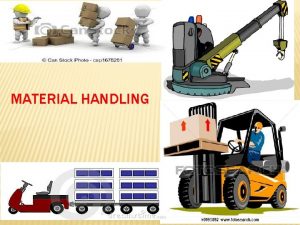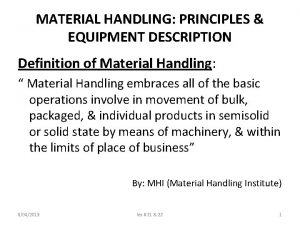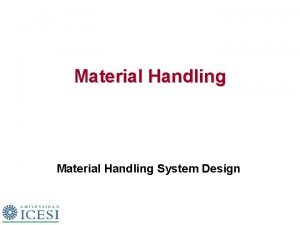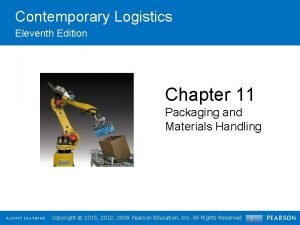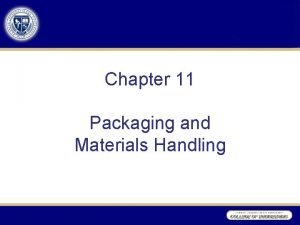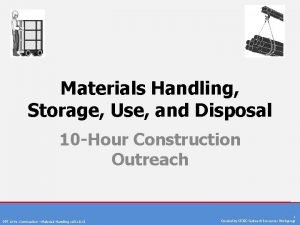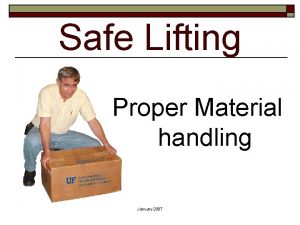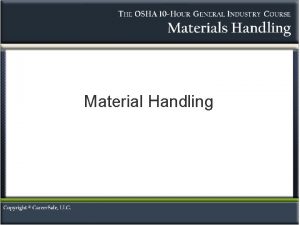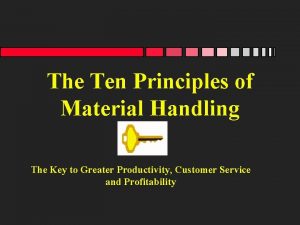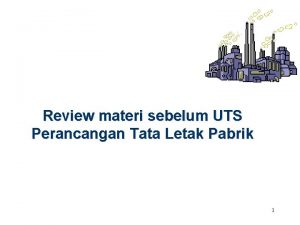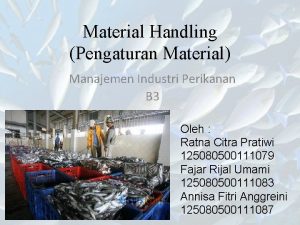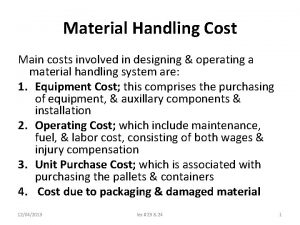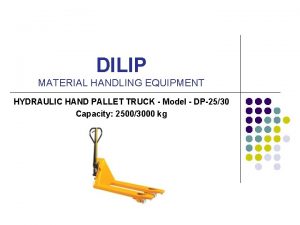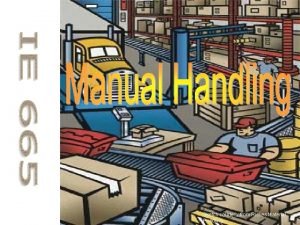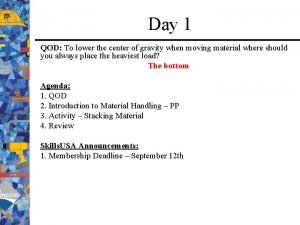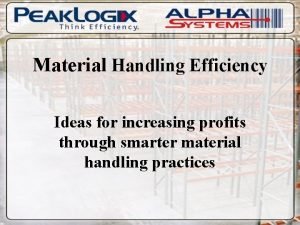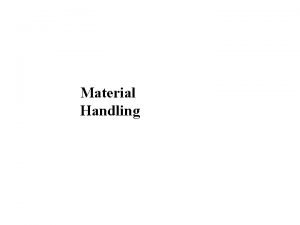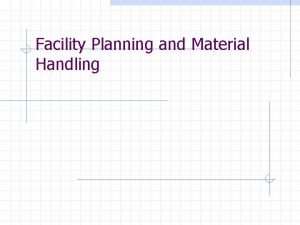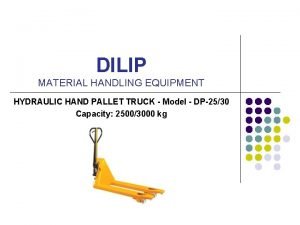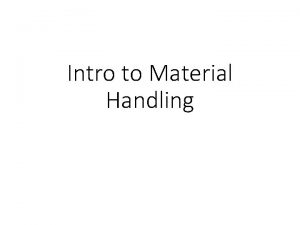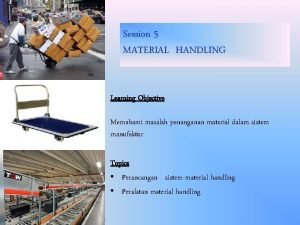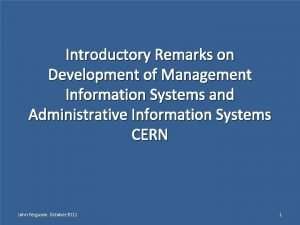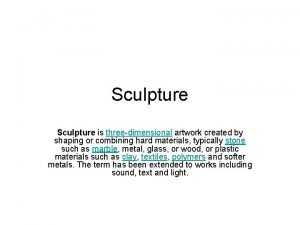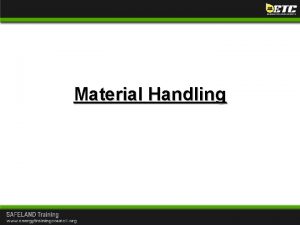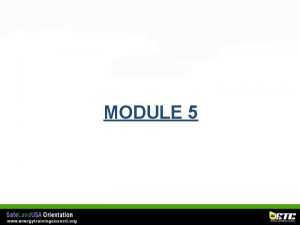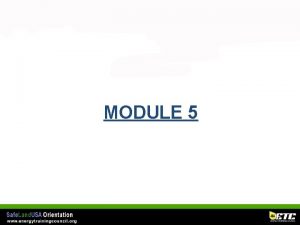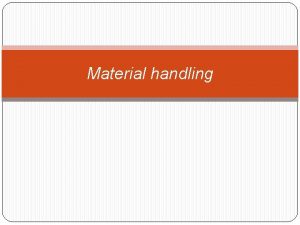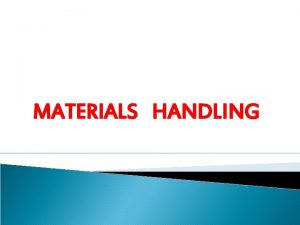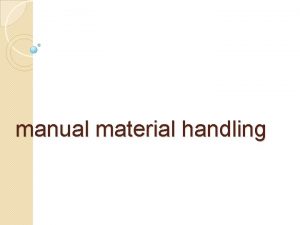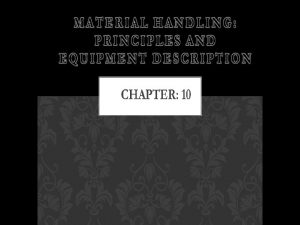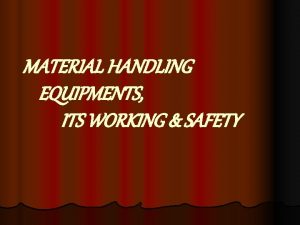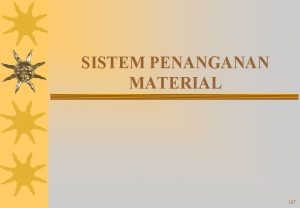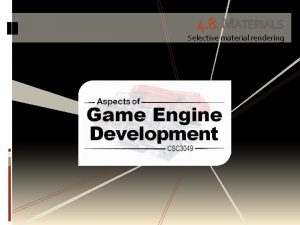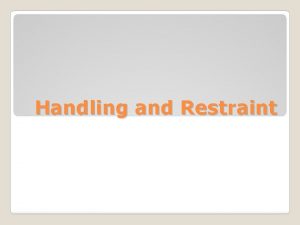MATERIAL HANDLING DEFINITION Materials handling is the art












































- Slides: 44

MATERIAL HANDLING

DEFINITION : � � Materials handling is the art and science involving the moving, packaging and storing of substances in any form. OR Materials handling is the movement and storage of materials at the lowest possible cost through the use of proper methods and equipment. OR Materials handling is the moving of materials or product by any means, including storage, and all movements except processing operations and inspection. OR Materials handling is the art and science of conveying, elevating, positioning, transporting, packaging and storing of materials.

A WELL DESIGNED MATERIALS HANDLING SYSTEM ATTEMPTS TO ACHIEVE THE FOLLOWING: 1. 2. 3. 4. Improve efficiency of a production system by ensuring the right quantity of materials delivered at the right place at the right time most economically. Cut down indirect labor cost. Reduce damage of materials during storage and movement. Maximize space utilization by proper storage of materials and thereby reduce storage and handling cost.

5. Minimize accident during materials handling. 6. Reduce overall cost by improving materials handling. 7. Improve customer services by supplying materials in a manner convenient for handlings.

PRINCIPLES OF MATERIAL HANDLING : PLANNING PRINCIPLE STANDARDIZATION PRINCIPLE WORK PRINCIPLE ERGONOMIC PRINCIPLE UNIT LOAD PRINCIPLE SPACE UTILIZATION PRINCIPLE SYSTEM PRINCIPLE AUTOMATION PRINCIPLE ENVIRONMENTAL PRINCIPLE LIFE CYCLE COST PRINCIPLE

1. PLANNING PRINCIPLE

PLANNING PRINCIPLE All material handling should be the result of a deliberate plan where the needs, performance objectives and functional specification of the proposed methods are completely defined at the outset. A material handing plan defines the material (what) and the moves (when and where); together they define the method (how and who).

2. STANDARDIZATION PRINCIPLE � � � Material handling methods, equipment, controls and software should be standardized within the limits of achieving overall performance objectives and without sacrificing needed flexibility , modularity and throughput anticipation of changing future requirements The planner should select methods and equipment that can perform a variety of tasks under a variety of operating conditions Standardization applies to sizes of containers and other load forming components as well as operating procedures and equipment

3. WORK PRINCIPLE � � Material handling work should be minimized without sacrificing productivity or the level of service required of the operation. Simplifying processes by reducing, combining, shortening or eliminating unnecessary moves will reduce work. Process methods, operation sequences and process/equipment layouts should be prepared that support the work minimization objective. Where possible, gravity should be used to move materials or to assist in their movement while respecting consideration of safety and the potential for product damage

4. ERGONOMIC PRINCIPLE Human capabilities and limitations must be recognized and respected in the design of material handling tasks and equipment to ensure safe and effective operations. � Equipment should be selected that eliminates repetitive and strenuous manual labor and which effectively interacts with human operators and users � The material handling workplace and the equipment employed to assist in that work must be designed so they are safe for people �

5. UNIT LOAD PRINCIPLE A unit load is one that can be stored or moved as a single entity at one time, such as a pallet, container or tote, regardless of the number of individual items that make up the load. � Less effort and work is required to collect and move many individual items as a single load than to move many items one at a time. � During manufacturing, smaller unit loads, including as few as one item, yield less in-process inventory and shorter item throughput times. �

6. SPACE UTILIZATION PRINCIPLE Space in material handling is three dimensional and therefore is counted as cubic space. � Effective and efficient use must be made of all available space. � In work areas, cluttered and unorganized spaces and blocked aisles should be eliminated. � In storage areas, the objective of maximizing storage density must be balanced against accessibility and selectivity. � When transporting loads within a facility the use of overhead space should be considered as an option. �

7. SYSTEM PRINCIPLE � Material movement and storage activities should be fully integrated to form a coordinated, operational system which spans receiving, inspection, storage, production, assembly, packaging, unitizing, order selection, shipping, transportation and the handling of returns.

8. AUTOMATION PRINCIPLE Material handling operations should be mechanized and/or automated where feasible to improve operational efficiency, increase responsiveness, improve consistency and predictability. � Computerized material handling systems should be considered where appropriate for effective integration of material flow and information management. � All items expected to be handled automatically must have features that accommodate mechanized and automated handling. �

9. ENVIRONMENTAL PRINCIPLE Environmental impact and energy consumption should be considered as criteria when designing or selecting alternative equipment and material handling systems. � Containers, pallets and other products used to form and protect unit loads should be designed for reusability when possible and/or biodegradability as appropriate. � Systems design should accommodate the handling of empty containers and other by-products of material handling. �

10. LIFE CYCLE COST PRINCIPLE Life cycle costs include all cash flows that will occur between the time the first dollar is spent to plan or procure a new piece of equipment, or to put in place a new method, until that method and/or equipment is totally replaced. � A thorough economic analysis should account for the entire life cycle of all material handling equipment and resulting systems. � A long-range plan for replacement of the equipment when it becomes obsolete should be prepared. �

TYPES OF MATERIAL HANDLING � CONVEYORS � HOISTS AND CRANES � FORKLIFT TRUCK � TROLLEY

CONVEYOR � It is a material handling device used for moving material over a fixed path in a factory CONVEY OR BELT CONVEY OR ROLLER CONVEY OR SCREW CONVEY OR BUCKET CONVEY OR

BELT CONVEYOR Can operate in horizontal direction only

ROLLER CONVEYOR It may be gravity operated or power operated It can move the material along straight or curved path It can operate in horizontal direction only

SCREW CONVEYOR � Can operate in horizontal, vertical and inclined direction � videosVertical Screw Conveyor test for Nestle powdered sugar - You. Tube (360 p). mp 4`

BUCKET CONVEYOR � Uses buckets arranged at regular intervals for the movement of material � Operated in vertical or in inclined direction � videosGough Engineering Swinglink Bucket Elevator conveying wrapped confectionery You. Tube (360 p). mp 4

HOIST � Mechanical device that can be used to raise and lower loads. � Its available in different capacities depending upon the load to be carried � videos12 ft. Tripod with chain hoist - Great way to move heavy logs! - You. Tube (360 p). mp 4

CRANES Designed for lifting and moving heavy loads using one or more overhead beams for support. Hoist is mounted in a crane to a trolley which allows horizontal movement of material CRANES BRIDGE CRANE GANTRY CRANE JIB CRANE

BRIDGE CRANE � Also called as EOT Crane (Electric overhead travel) � Two horizontal girders suspended between fixed rails on either end to form a rectangle. � This entire unit is connected to the structure of the building

PER_DEEPIKAVIDEOSEOT CRANE VIDEO. MP 4

GANTRY CRANE � � � Similar to bridge crane Crane structure is mounted on wheels and can be moved at the place of use Vertical lifting is accomplished by hoist


JIB CRANE � Also called as pillar crane � It consist of the Horizontal beam that comes out from the vertical beam or wall support

PER_DEEPIKAvideosjib cranes video. mp 4

FORK LIFT TRUCK � Industrial truck of small capacity having two forks attached to the column of the truck. � Used for transporting material at a distance inside a factory. � Can be also used to stack material at the height.

PER_DEEPIKAVIDEOSFORK LIFT VIDEO. MP 4

TROLLEY

CRITERIA FOR THE SELECTION OF MATERIAL HANDLING EQUIPMENT � Material to be moved � Plant buildings and layout � Type of production machines � Type of material flow pattern � Type of production � Cost of material handling equipment � Handling cost � List of the equipment � Amount of care & maintenance require for the material handling

AUTOMATED GUIDE VEHICLES

AUTOMATED GUIDED VEHICLES (AGV) “A driverless vehicle used to move materials efficiently in a facility” AGVs are sophisticated machines that represent a complete material handling solution and are installed in numerous industries and a wide range of applications. AGVs can increase efficiency and productivity as well as reduce product damage and labor costs.

VEHICLE FUNCTIONS: MAN/VEHICLE FUNCTIONS q Inputs made via operator panel with its keyboard and display q Destination input to the vehicle q Plug-in manual control and diagnosis module Route (destination) finding q High vehicle intelligence q Travel route topology stored in the vehicle q Destination code processing q Load-sensing and empty location recognition

Data exchange � Infrared � Radio Special functions � Battery reserve monitoring � Control of battery charging � Obstacle recognition Load handling � Load acceptance � Load depositing � Load monitoring � Load transfer synchronization

Travel control � Speed � Safety gap maintenance � Collision protection.

DIFFERENT TYPES OF AVGS � FORK

TOW/TUGGER

UNIT LOAD

CUSTOM

VIDEOS : � PER_DEEPIKAvideosToyota's Automated Guided Vehicles (AGVs) (1). mp 4 � PER_DEEPIKAvideosAutomated Guided Vehicles (AGV) for fully-automated pallet transport, Fashion Logistics. mp 4
 Define materials handling
Define materials handling Dead weight principle in material handling
Dead weight principle in material handling Unit load
Unit load Protective packaging and materials handling
Protective packaging and materials handling Let there be light lamp shade company
Let there be light lamp shade company Material handling and storage safety ppt
Material handling and storage safety ppt Use and care of the library
Use and care of the library Proper handling of materials
Proper handling of materials Introduction to material handling
Introduction to material handling What is the unit load principle
What is the unit load principle Contoh soal tata letak fasilitas
Contoh soal tata letak fasilitas Manajemen industri perikanan
Manajemen industri perikanan Material handling costs
Material handling costs Dilip material handling equipment
Dilip material handling equipment Riekes material handling
Riekes material handling To work with motorized material-handling device
To work with motorized material-handling device Material handling efficiency
Material handling efficiency Material handling objectives
Material handling objectives Material handling and facilities planning
Material handling and facilities planning Dilip lift truck
Dilip lift truck Welding robots ppt
Welding robots ppt The forklift hand signal for dog everything means
The forklift hand signal for dog everything means Prinsip material handling
Prinsip material handling Go noodle cant stop the feeling
Go noodle cant stop the feeling Household materials harmful and useful
Household materials harmful and useful Man made map
Man made map What is adopting materials
What is adopting materials Direct materials budget with multiple materials
Direct materials budget with multiple materials Gd&t symbol
Gd&t symbol Usage variance formula
Usage variance formula Non material culture examples
Non material culture examples The knowledge language values customs and material objects
The knowledge language values customs and material objects All groups create norms to enforce their cultural values.
All groups create norms to enforce their cultural values. Edh cern
Edh cern A 3-d work of art created by shaping or combining materials
A 3-d work of art created by shaping or combining materials Hát kết hợp bộ gõ cơ thể
Hát kết hợp bộ gõ cơ thể Slidetodoc
Slidetodoc Bổ thể
Bổ thể Tỉ lệ cơ thể trẻ em
Tỉ lệ cơ thể trẻ em Gấu đi như thế nào
Gấu đi như thế nào Chụp phim tư thế worms-breton
Chụp phim tư thế worms-breton Chúa yêu trần thế
Chúa yêu trần thế Các môn thể thao bắt đầu bằng tiếng bóng
Các môn thể thao bắt đầu bằng tiếng bóng Thế nào là hệ số cao nhất
Thế nào là hệ số cao nhất Các châu lục và đại dương trên thế giới
Các châu lục và đại dương trên thế giới
